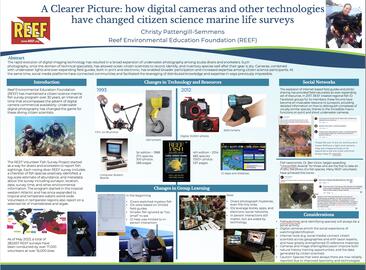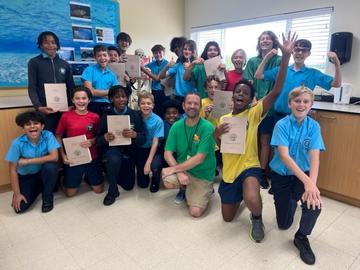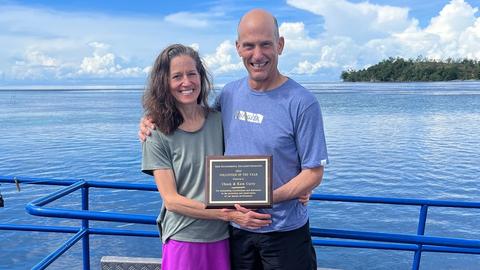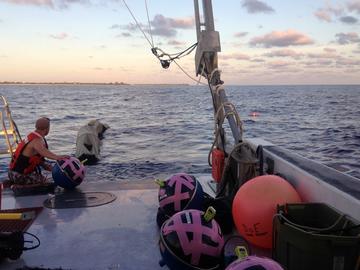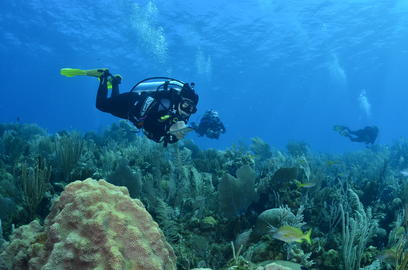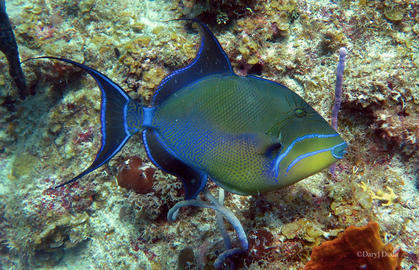Laws protecting the Atlantic Goliath Grouper Epinephelus itajara from fishing in federal and state waters of the United States occurred in 1990 after the species was identified as being severely overfished. Population increases that occurred during the first 20 years of the closure were followed by a decline in the 10 years thereafter.
Dr. Christy Pattengill-Semmens, REEF Co-Executive Director of Science and Engagement, recently attended the 2023 Citizen Science Association Conference to share information about the Volunteer Fish Survey Project (VFSP). The semi-annual conference brings together a wide variety of practitioners, volunteers, academics, educators, and more, to share ideas and insights, and to forge stronger relationships and practices across the field.
The Grouper Moon Project is a conservation science partnership between REEF, and the Cayman Islands Department of Environment (DoE), with scientists from Scripps Institution of Oceanography at UC San Diego and Oregon State University, aimed at studying endangered Nassau grouper, a social and ecological corner stone of Caribbean's coral reefs. In 2011, REEF and DoE created the Grouper Education Program, a suite of marine science lessons and activities to accompany the Grouper Moon Project.
We are thrilled to share that Chuck and Kara Curry are our 2022 REEF Volunteers of the Year. Chuck joined REEF in 2013, and Kara joined a few years later in 2016, after meeting Chuck during a dive trip to Cuba. Since then, they have both joined the ranks as some of the top surveyors for the REEF Volunteer Fish Survey Project. Collectively, they have submitted over 2,500 surveys in the VFSP database. In 2022 alone, they conducted 448 surveys. Unsurprisingly, Chuck and Kara have both achieved the coveted Golden Hamlet award for submitting over 1,000 surveys.
We are excited to share the latest scientific paper from the Grouper Moon Project. The study, published last month in the journal Proceedings of the Royal Society B, addresses the question of where fertilized eggs go after being released by Nassau Grouper at their spawning site off the west end of Little Cayman. This study used state-of-the-art technology, including satelite-tracked drifters, an underwater microscope, and a glider to raise and lower the instruments.
This publication from the Grouper Moon Project addresses the question of where fertilized eggs go after being released by Nassau Grouper at their spawning site off the west end of Little Cayman. On nights of spawning in 2017, researchers physically tracked clouds of tiny, transparent Nassau Grouper eggs through the night with an underwater microscope developed by scientists at Scripps Oceanography. Results show that fertilized eggs from Little Cayman floated back onto reefs on the island.
Did you know that April is Citizen Science Month? Coordinated by SciStarter, Citizen Science Month helps raise awareness of opportunities for everyone to participate in science in meaningful ways. Citizen science is at the heart of REEF's work with the Volunteer Fish Survey Project (VFSP). Since its launch in 1993, the VFSP has generated one of the largest marine life databases in the world. As of April 1, 2023, the REEF VFSP database has 281,606 surveys conducted at 16,189 sites throughout the world’s oceans, by 17,030 volunteer divers and snorkelers worldwide.
We are excited to share a new scientific paper published last month in the journal Environmental Biology of Fishes. This study, conducted by our Grouper Moon Project team, reports on the movement patterns and spawning behavior of Tiger Grouper during their reproductive season, helping to shed light on an important, but poorly studied, member of Caribbean coral reef ecosystems.
This study, conducted as part of the Grouper Moon Project, reports on the movement patterns and spawning behavior of Tiger Grouper during their reproductive season. Tiger Grouper is one of over 20 species of reef fish that are known to use the western tip of Little Cayman in the Cayman Islands as a spawning ground. This multi-species aggregation is best known for being home to the largest and one of the last known spawning aggregations of Nassau Grouper.
We're excited to share another story about the power of REEF citizen science data. Last month, researchers from University of Miami published a new paper in the scientific journal Fisheries Management and Ecology, which used REEF Volunteer Fish Survey Project (VFSP) data to help model population trends in coral reef fish species.

